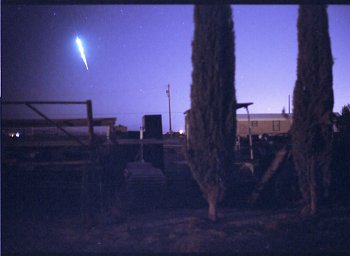
Surely you've read the news story about a Chilean jet narrowly missing space debris near New Zealand. I can safely say, as the story is written, it didn't happen.
Meteors are notoriously described with outrageously close distances-- "extinguished below the horizon", "no more than 3 - 5 thousand feet high when directly above me", etc., despite the luminous portion of the meteor flight starting at 120-75km altitude, and ending by 20km altitude. How did the pilot see this object, if it was no longer luminous, at his flight elevation? Let alone "knowing" it was only five miles away from the plane. Likely, he had received notice that the Russians were deorbiting a satellite that day, albeit twelve hours later, and saw the meteor and mistakenly claims near-disaster.
Pilots have long mistaken meteors as being close--the grandfather of meteoritics,
Harvey H. Nininger, called their reports "humorous at best". In fact, you should read that entire article: http://www.meteoritearticles.com/mitterling17.html.
During Nininger's time a number of airpilots reported having to take evasive steps to prevent collisions with falling meteors. One such newspaper reported an startling account of how a resourceful pilot battled a shower of meteors by making a serious of dips and swerves to avoid the incoming falling meteors saving himself, his eleven passengers, as well as the aircraft. One other pilot was said to have dipped his right wing to avoid a similar collision of a meteor which happened in Nebraska. Yet another pilot near Cheyenne Wyoming said he narrowly escaped injury when en-countering one of those pestiferous fiery projectiles which threaten to side swipe him from the left. He "ducked", however and the missile sailed by, leaving him unharmed.
...
Nininger knew of the fall of those cited above and concluded that the second pilot who thought he saw the meteor below him, plotted the meteor height at the burnout point at about 17 miles high, above the northeastern New Mexico soil. The second pilot who saw the same meteor fall was slightly more than a hundred miles from it at its nearest approach. The pilot over Nebraska that dipped his wing to avoid collision was 68 miles south of the line over which the dreaded missile was speeding at an elevation of approximately 20 miles.
Pilots in the 1920's were having difficulty giving range to bright objects--what makes anyone think they still aren't?
2 comments:
There's also this one:
Russia hits back at space blunder claim [Fairfax Digital]
http://tinyurl.com/29yq6o
..."Johnson said there are no other reports from the US Space Surveillance Network of other re-entering space junk at the time, so the flaming objects must have been fragments of a meteor."
So this whole meteor craziness doesn't look as totally unjustified:
Forget About Global Warming: We're One Step From Extinction!
[Signs of the Times]
http://tinyurl.com/2wsj9a
Please note that Abell is suggesting that some of Jupiter's moons have been captured by Jupiter's gravity.
Now let's time travel back to the future, and see what the latest information tells us about Jupiter's moons:
Jupiter is now given 63 satellites. Forty-seven of those satellites have been discovered since 1999. What if they weren't there before?
What about Saturn. Our 1975 text tells us that Saturn has 10 satellites. In 2007? Well, there are so many that one source declines to give a precise number!
However, counting the named satellites on the Timeline of discovery of solar system planets and their natural satellites gives us a count of 62, with 41 being discovered since 2000 and another ten in the 80's and 90's.
Moving outward, we come to Uranus, given five satellites in 1975, it now has 28, with ten being discovered in the 1980's, six in the 90's, and 7 since 2000.
Neptune had two satellites in 1975, now it has 13.
(...)
The explanation given most often to explain this surge in the numbers of satellites for these planets is that telescopes have gotten better. That is, we can see further, with greater detail, and can therefore find things that we couldn't see before. It is an explanation that makes sense. One small problem with this theory is that the "new" moons of Neptune and Uranus showed up before the new moons of Jupiter and Saturn. One would think that powerful telescopes capable of finding moons as far away as the seventh and eighth planets would have found the hard to see moons of the fifth and sixth first.
Another possible explanation, and one which fits with new moons appearing around Neptune and Uranus prior to appearing around Jupiter and Saturn, is that these new moons, or some of them, are objects that have been trapped into orbits around these planets only recently, that they were captured by the gravity of these planets and removed from the incoming comet cloud. Passing the orbits of the outer planets first, they would arrive at the inner planets afterward.
We also note that the much derided Immanuel Velikovsky, in his book Worlds in Collision, gives a time frame of nine years as the time it would take for a comet to cover the distance between Jupiter and Earth. The new Jovian moons were discovered beginning in the late nineties.
Do the math.
Dear eccentric enthusiast:
If you believe meteor rates have skyrocketed, please check the automated recording rates at http://visualrmob.free.fr/index.php, etc., to see that rates haven't.
Also, the latest discoveries at Jupiter are entirely of a result of Sheppard and Jewitt searching the entire Hill sphere of Jupiter with the latest telescope and detector technology. Not that there are more; it's very difficult for new moons to be gravitationally caught.
Post a Comment